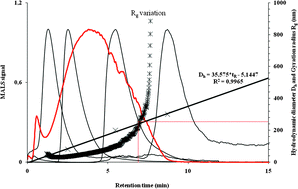A new analytical approach based on asymmetrical flow field-flow fractionation coupled to ultraviolet spectrometry and light scattering detection for SWCNT aqueous dispersion studies
Abstract
This work demonstrates the potential of asymmetrical

* Corresponding authors
a
Université de Pau et des Pays de l'Adour (UPPA)/CNRS, Laboratoire de Chimie analytique Bio-Inorganique et Environnement, UMR IPREM 5254—Technopôle Hélioparc, Av. du Président Angot, Pau Cedex, France
E-mail:
gaetane.lespes@univ-pau.fr
Fax: +33 (0)559407674
Tel: +33 (0)559407671
This work demonstrates the potential of asymmetrical

 Please wait while we load your content...
Something went wrong. Try again?
Please wait while we load your content...
Something went wrong. Try again?
J. Gigault, B. Grassl and G. Lespes, Analyst, 2012, 137, 917 DOI: 10.1039/C2AN15449H
To request permission to reproduce material from this article, please go to the Copyright Clearance Center request page.
If you are an author contributing to an RSC publication, you do not need to request permission provided correct acknowledgement is given.
If you are the author of this article, you do not need to request permission to reproduce figures and diagrams provided correct acknowledgement is given. If you want to reproduce the whole article in a third-party publication (excluding your thesis/dissertation for which permission is not required) please go to the Copyright Clearance Center request page.
Read more about how to correctly acknowledge RSC content.
 Fetching data from CrossRef.
Fetching data from CrossRef.
This may take some time to load.
Loading related content
